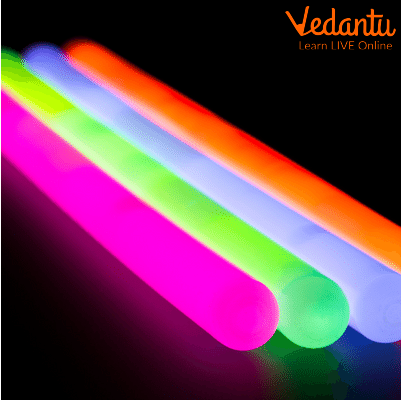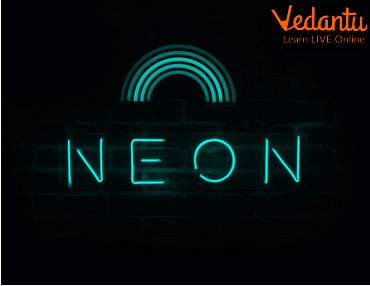




Introduction to Neon Signs Blue
It's impossible to ignore neon hues, also referred to as fluorescent colours. These brilliant hues have seen numerous fashion fads throughout history and are frequently seen on signs, nail polish, and vintage clothing from the 1980s.

Neon Signs Blue
They are definitely not the kinds of colours you would see in nature, but they have only been present for the past century. Therefore, just like the colours themselves, their history is different and colourful. By going through the following sections, children will be able to answer every question like what element makes glowing signs, what makes a colour neon, etc.
What Colours are Neon?

What Colours are Neon?
When placed in a vacuum in the presence of an electric current, pure neon gas emits a vivid red-orange glow. Other gasses that are used in neon signs have hues other than red-orange.
The most loud-sounding and brilliant colour schemes are neon ones. For instance, neon lights are so bright at night that they can be seen from a mile away. They work best when you want to draw attention in a crowded area.
Neon colours are also the ideal option for converting any room into a vibrant, energetic setting. They may be used with a variety of colour schemes and interior designs to make any space feel warm and welcoming.
What Makes a Colour Neon?

What Makes a Colour Neon?
Many places are often lit up with neon signs at night. These vibrant glass tubes can be used to create letters or shapes that make words. The gas used to fill part of the tubes gives neon lights their name. The colour is created by this gas. One of the elements classified as noble gasses is neon. Each noble gas emits a distinct radiance.
The gasses can be blended to produce new colours, and they change colour as electricity is carried through them. Neon produces the colours red and orange, whereas argon filled within tubes with a green fluorescent coating produces green. In a gold glass tube, argon and helium are combined to create gold; argon and xenon are combined to create pink, and pure xenon is used to create white.
Neon Signs

Neon Sign Blue
Glass tubes carrying neon gas and a small bit of argon gas make up a conventional neon sign. Despite the fact that neon is used to describe signs of many colours, not all colours can be produced using neon. For instance, helium, not neon, is used to create a yellow "neon" sign. Again similarly, neon signs blue are produced when metallic mercury and neon gas are combined.
List of Neon Light Colours

List of Neon Light Colours
Following is the list of Neon Light colours:
Green:
Neon
Green
UFO Green
Electric Lime
Red:
Neon Red
Electric Orange
Yellow:
Neon Yellow
Absinthe
Chartreuse Yellow
Pink:
Neon Pink
Neon Magenta
Plastic Pink
Purple:
Neon Purple
Proton Purple
Blue:
Neon Blue
Electric Cyan
The Meaning Behind Neon Colours
Neon colours take on some of their related colours' psychological characteristics. While neon pink embodies the joy and playfulness of pink, electric blue can have a calming and beautiful feeling similar to that of pure blues.
Fluorescent colours haven't always been thought of as being aesthetically pleasing because they are bold, unnatural, and bright.
Neon colours are associated with pleasure and excess, whereas neutral colours have a more stylish and sophisticated reputation. Links to fluorescent signs help to further establish neon's association with nightlife, clubbing, and cities at night, especially when it is coupled with dark hues like midnight blue or black.
Due to their employment in highly visible clothing and signs, neon colours can also be connected to caution and danger.
Summary
Although neon colours aren't as popular now, they still exist in a variety of shapes and patterns. Today, you can still find neon-coloured apparel, makeup, hair colouring, and glow sticks.
These bold hues may no longer be the standard for fashion, but they may nevertheless make a person stand out in a crowd.
FAQs on Neon Signs Blue: Knowing Science Better!
1. What element makes glowing signs, and what distinguishes neon from fluorescent colours?
Neon is the element that is used for making glowing signs. Mercury, argon, and helium are the three most popular glasses used to create neon signs that are brilliant and multi-coloured.
The words neon and fluorescent colour are sometimes used together even though neon and fluorescent lights are different. Any colour that emits more light than a typical colour is referred to as fluorescent. However, the term "neon" is now frequently used to describe any such colour that appears to glow.
2. Why are neon signs blue so expensive and what colours are neon?
Neon signs Blue require expensive parts to build them. Neon sign manufacturers, therefore, mark up these costs and pass them along to consumers in the form of higher prices. Additionally, the cost of the components is not limited to their purchase; their handling may also be costly.
Extremely vivid variations of primary and secondary colours including blue, red, green, yellow, and purple are known as fluorescent or neon colours. Fluorescent colours differ from other varieties of colour because they emit light, which makes them shine out.









